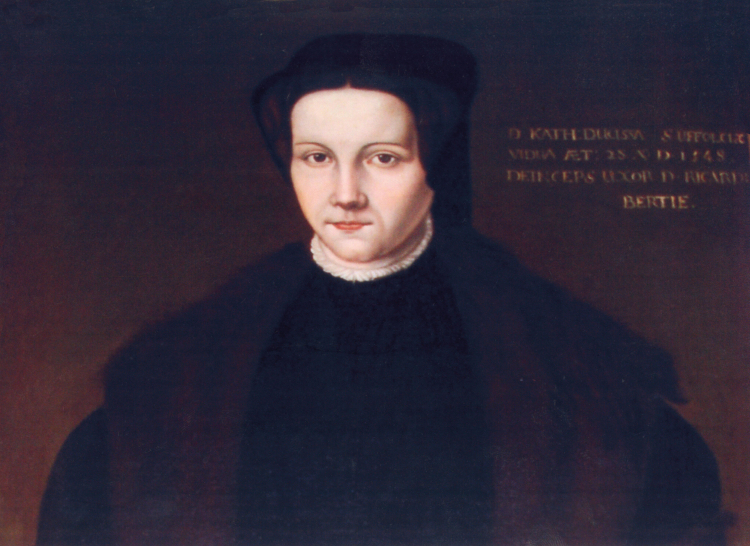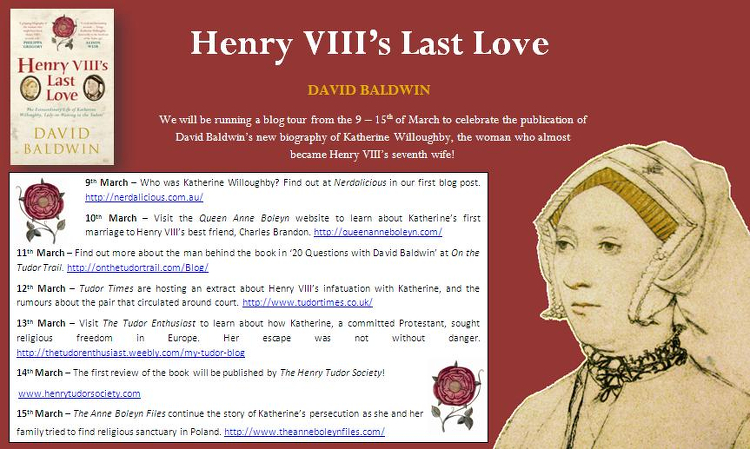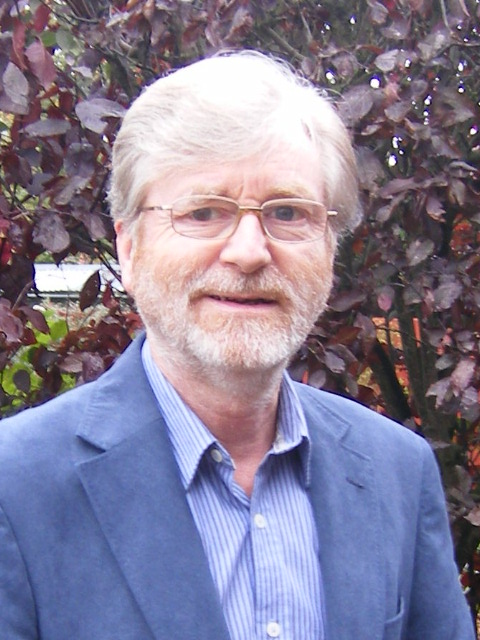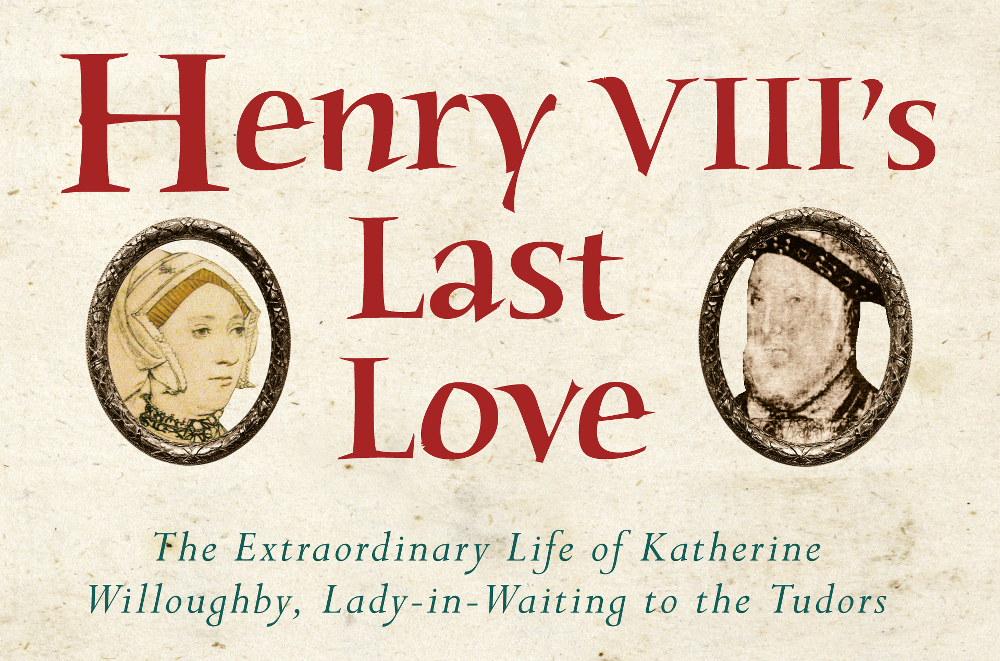
Today we’re pleased to be launching the book tour for David Baldwin’s highly-anticipated Henry VIII’s Last Love: The Extraordinary Life of Katherine Willoughby, Lady in Waiting to the Tudors. In this exclusive excerpt David introduces us to the remarkable woman who lived through the reigns of four Tudor monarchs, Katherine Willoughby.
“Who was Katherine Willoughby? This excerpt from the introduction to Henry VIII’s Last Love explains.” – David Baldwin
Katherine Willoughby is today less well known than some other Tudor ladies, but was at the forefront of the profound political and religious changes that transformed England in the reigns of King Henry VIII and his children, Edward VI, Mary I and Elizabeth I. She was born at Parham Old Hall, near Framlingham (Suffolk), in 1519, the only surviving child of William, eleventh Baron Willoughby and his wife, Maria de Salinas, a Spanish lady-in-waiting to Queen Catherine of Aragon. She inherited the family properties on her father’s death in 1526, but her uncle Sir Christopher Willoughby claimed that some manors had been promised to him under the terms of an earlier settlement. The resulting dispute soured their relationship for four decades, and became the first of the many threats she would encounter in the course of her long life.
Katherine was married to Charles Brandon, Duke of Suffolk, King Henry’s closest friend, at the age of just fourteen. The death of his previous wife, Henry’s sister Mary, had robbed Brandon of a significant part of his income; but he loyally supported the king against the rising known as the Pilgrimage of Grace and was rewarded with authority in Lincolnshire and additional wealth in the form of lands forfeited by dissolved monasteries. Katherine became a great lady, ruling over her houses at Grimsthorpe and Tattershall, and was frequently a guest at Henry’s banquets and weddings. She grew to know the king well – in 1538, only three months after Queen Jane Seymour’s death, it was reported that they had been ‘masking and visiting’ together – and in 1543 she became a lady-in-waiting to his sixth wife Catherine Parr. Henry had a reputation for tiring of his wives once the excitement of the pursuit was over – particularly if they had failed to give him male children – and in February 1546, only six months after Charles Brandon’s death, it was rumoured that the king meant to wed her himself if – and when – he could end his present marriage. Catherine Parr’s Protestant religious views, which often ran contrary to the king’s, were potentially treasonable, and that summer it appeared that she was about to be arrested and executed. But Henry forgave her or changed his mind at the last moment, and Katherine Willoughby never became his seventh queen. Instead she took her gentleman usher, Richard Bertie, as her second husband, and retained a degree of independence she would not have enjoyed if she had married another peer.
Katherine was by this time the most fervent of English Protestants – although her mother had been a committed Roman Catholic – and the tragedy of losing both her sons by the duke to the ‘sweating sickness’ in 1551 did nothing to diminish her belief in the divine goodness. She avoided involvement in the conspiracy built around her step-granddaughter Lady Jane Grey in 1553, but was still obliged to spend four eventful years in exile in Europe beyond the reach of the Catholic Queen Mary. Here she lived from hand to mouth, gave birth to another son, and moved from city to city to avoid the attentions of the queen’s agents before finally finding sanctuary in Poland. She returned home when Elizabeth succeeded, but was bitterly disappointed that the new queen’s approach to religious matters was always more pragmatic and less enthusiastic than her own. Her sufferings for the Protestant cause earned her a place in Foxe’s Book of Martyrs; her last years were clouded by her son’s waywardness and her dislike of, and differences with, her daughter-in-law; and at the end she feared that Elizabeth was about to have her executed – a fear expressed in dramatic terms in her letter to the Earl of Leicester discussed in the Prologue. Hers was a life of privilege mixed with tragedy and danger, but she kept her head on her shoulders when many of her contemporaries lost theirs for less cause.

@David Baldwin 2015. Do not reproduce.
Excerpt from David Baldwin’s new book, Henry VIII’s Last Love: The Extraordinary Life of Katherine Willoughby, Lady in Waiting to the Tudors, published by Amberley, 2015
Join David on his book tour at Queen Anne Boleyn, On The Tudor Trail, Tudor Times, The Tudor Enthusiast, The Henry Tudor Society and The Anne Boleyn Files.

Henry VIII’s Last Love: The Extraordinary Life of Katherine Willoughby, Lady in Waiting to the Tudors is available now from all good bookstores, and online at Amberley’s online shop and The Book Depository.
 David Baldwin is a Fellow of the Royal Historical Society who devised and taught courses for adults at the Universities of Leicester and Nottingham for more than twenty years. His 2002 biography of Queen Elizabeth Woodville (Elizabeth Woodville, Mother of the Princes in the Tower) has been reprinted many times, and his other books include Stoke Field The Last Battle of the Wars of the Roses (Pen & Sword, 2006), The Lost Prince, The Survival of Richard of York (The History Press, 2007), The Kingmaker’s Sisters, Six Women in the Wars of the Roses (The History Press, 2009), The Women of the Cousins’ War [with Philippa Gregory and Michael Jones] (Simon & Schuster, 2011), Richard III (Amberley, 2012), and Richard III, The Leicester Connection (Pitkin, 2013).
David Baldwin is a Fellow of the Royal Historical Society who devised and taught courses for adults at the Universities of Leicester and Nottingham for more than twenty years. His 2002 biography of Queen Elizabeth Woodville (Elizabeth Woodville, Mother of the Princes in the Tower) has been reprinted many times, and his other books include Stoke Field The Last Battle of the Wars of the Roses (Pen & Sword, 2006), The Lost Prince, The Survival of Richard of York (The History Press, 2007), The Kingmaker’s Sisters, Six Women in the Wars of the Roses (The History Press, 2009), The Women of the Cousins’ War [with Philippa Gregory and Michael Jones] (Simon & Schuster, 2011), Richard III (Amberley, 2012), and Richard III, The Leicester Connection (Pitkin, 2013).

Henry VIII’s Last Love: The Extraordinary Life of Katherine Willoughby, Lady in Waiting to the Tudors by David Baldwin, published by Amberley Publishing 2015.
In 1533 Katherine Willoughby married Charles Brandon, Henry VIII’s closest friend. She would go on to serve at the court of every Tudor monarch bar Henry VII and Mary Tudor. Duchess of Suffolk at the age of fourteen, she became a powerful woman ruling over her houses at Grimsthorpe and Tattershall in Lincolnshire and wielding subtle influence through her proximity to the king. She grew to know Henry well and in 1538, only three months after Jane Seymour’s death, it was reported that they had been ‘masking and visiting’ together. In 1543 she became a lady-in-waiting to his sixth wife Catherine Parr. Henry had a reputation for tiring of his wives once the excitement of the pursuit was over, and in February 1546, only six months after Charles Brandon’s death, it was rumoured that Henry intended to wed Katherine himself if he could end his present marriage. This is the remarkable story of a life of privilege, tragedy and danger, of a woman who so nearly became the seventh wife of Henry VIII.



